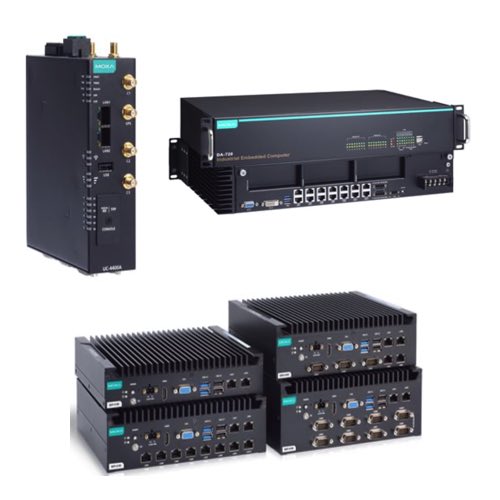Industrial Computers

Moxa’s industrial computers are built to perform reliably in mission-critical applications where standard commercial computers would fail. Designed for use in harsh and demanding environments, Moxa computers offer fanless, compact, and ruggedized designs with extended temperature, shock, and vibration tolerance. Their product lines, including the MC and V series, are optimized for transportation, oil and gas, energy, and factory automation applications. These computers support multiple serial, LAN, USB, and wireless interfaces, making them adaptable to a wide range of system requirements without sacrificing reliability or longevity.
These computers often run on embedded operating systems such as Linux or Windows IoT and support a variety of software platforms including Docker and proprietary SDKs. Moxa offers computers that serve as ideal edge gateways, enabling real-time data collection, protocol conversion, and cloud connectivity through platforms like AWS, Azure, or private servers. The inclusion of TPM security chips, dual LAN redundancy, and wide voltage input further supports industrial-grade cybersecurity and resilience. Their modular architecture allows for easy customization and future expansion, providing flexibility for OEMs and system integrators.
Basics of Switches, Routers & Hubs
Ethernet hubs, switches and routers connect computers to networks, devices and other computers.
Ethernet hubs are the least intelligent of the three devices. They simply take any message that is received and transmits it to every other device connected to that hub. For example, if CPU 1 on a network wants to send a message to CPU 5, it will send that message through the hub.The hub will then take that message and send it out to every connected device on that hub regardless of the intended target. When CPU 5 receives that message and wants to respond, it will send its response through the hub which sends it to every connected device. Ethernet hubs do not manage any data that is sent and tend to bog down networks. They also do not offer much security for the network. For these reasons, Ethernet hubs are are being replaced with network switches.
Switches transmit data from one device to another on the same network. Unlike a hub, switches use a switch table to learn where data came from and where to send it. Switch tables store Mac addresses and device ports. By storing this data, a switch can operate more efficiently than a hub, greatly reducing the traffic within the network.
Routers transfer data between devices while learning the location of those devices within the network. They are also a junction between two or more networks. An example of this would be a home router where the home network is connected to the Internet. Another example would be when the router connects two or more networks with different business functions. In addition to connecting two or more networks, a router offers important security features that help protect the network.

